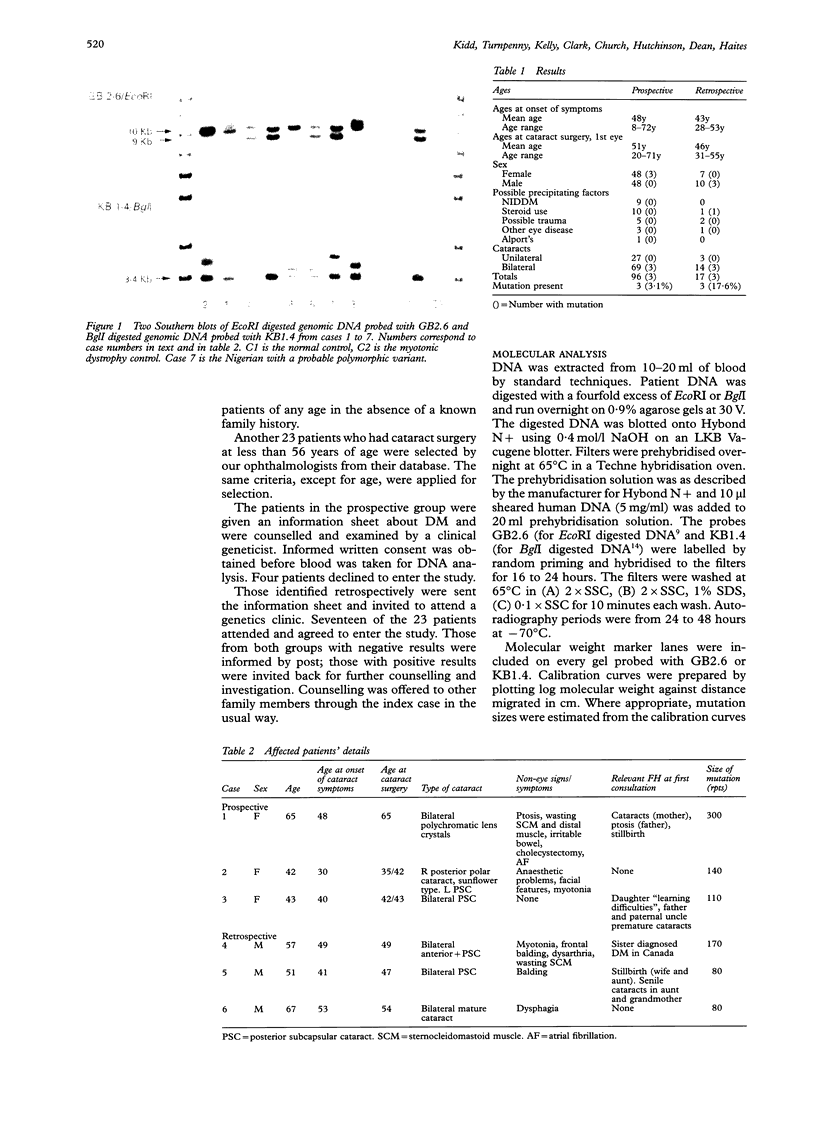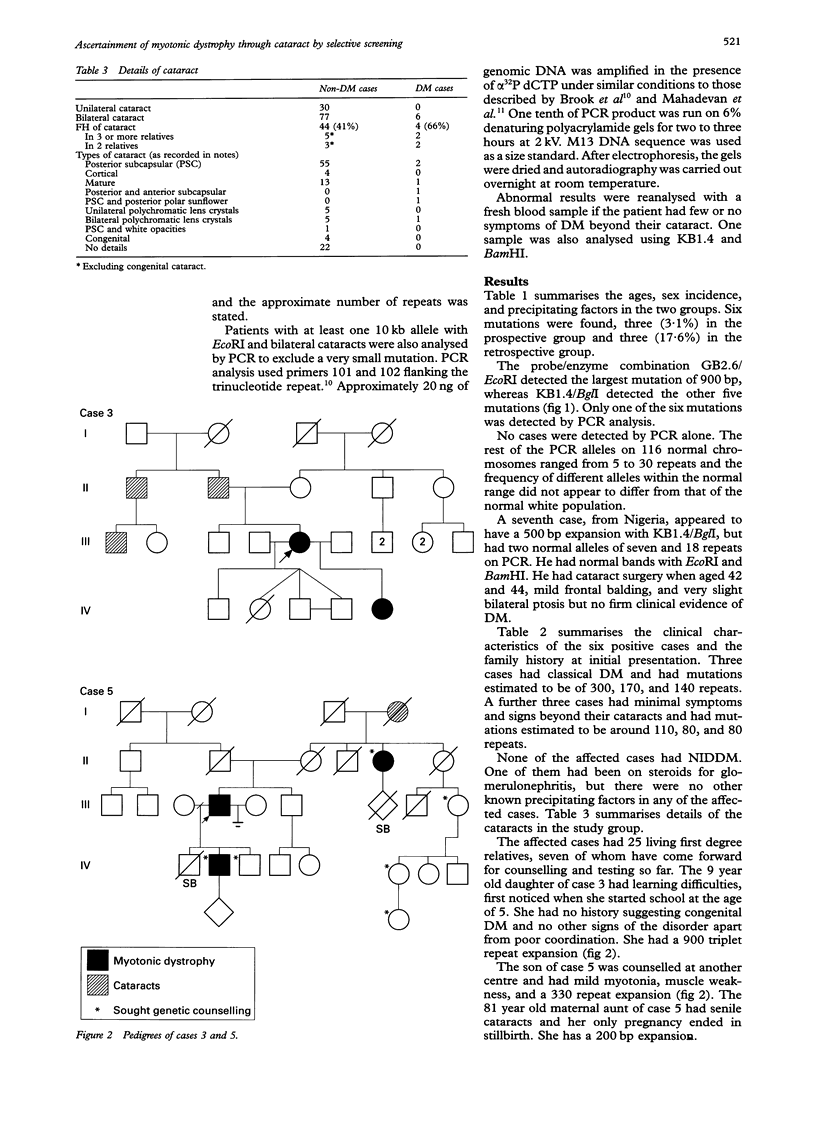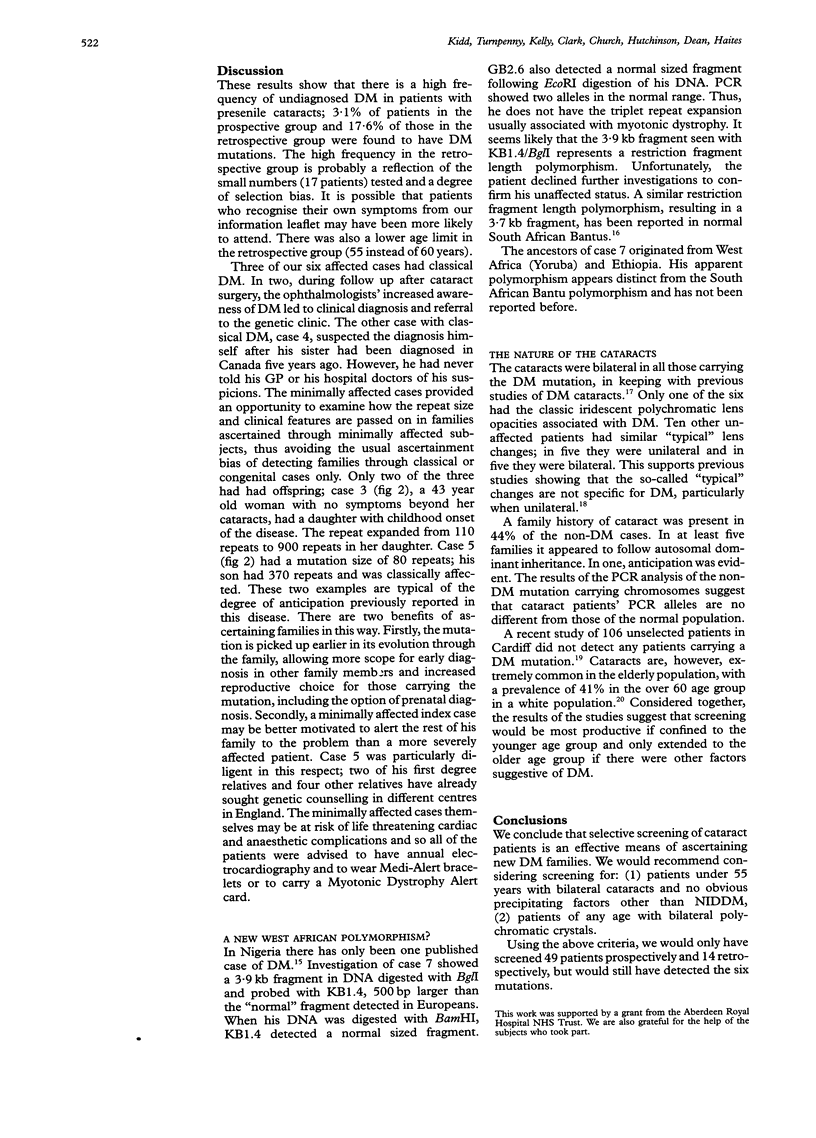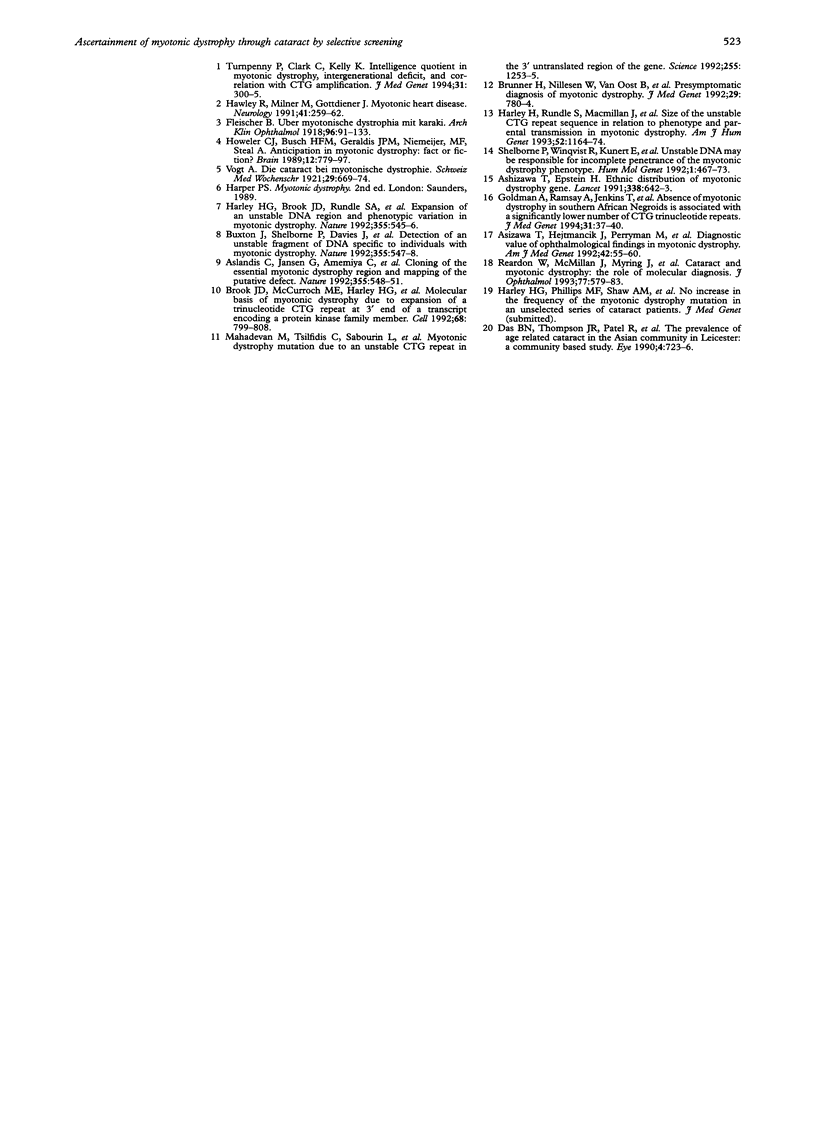Abstract
Myotonic dystrophy (DM) almost always results from the expansion of an unstable (CTG)n repeat. The mutation can be detected directly. Affected patients with cataracts may have minimal additional signs of the disorder, but all are at risk of life threatening complications. We have studied the efficacy of detecting new families with myotonic dystrophy by selectively screening cataract patients. Selection criteria were: age under 60 with no obvious precipitating factor (except non-insulin dependent diabetes mellitus (NIDDM)); patients of any age with other signs suggestive of myotonic dystrophy detected by the ophthalmologist. Ninety-six patients were tested prospectively; 17 others under 55 were screened retrospectively. All patients were counselled by a clinical geneticist before testing. The patients' DNA was analysed using the DNA probe/restriction enzyme combinations GB2.6/EcoRI, KB1.4/BglI and polymerase chain reaction (PCR). Six patients have been found to have a mutation, three (3.1%) in the prospective group and three (17.6%) in the retrospective group. Three of these patients had minimal myotonic dystrophy and three had classical DM.
Full text
PDF




Images in this article
Selected References
These references are in PubMed. This may not be the complete list of references from this article.
- Ashizawa T., Epstein H. F. Ethnic distribution of myotonic dystrophy gene. Lancet. 1991 Sep 7;338(8767):642–643. doi: 10.1016/0140-6736(91)90659-d. [DOI] [PubMed] [Google Scholar]
- Ashizawa T., Hejtmancik J. F., Liu J., Perryman M. B., Epstein H. F., Koch D. D. Diagnostic value of ophthalmologic findings in myotonic dystrophy: comparison with risks calculated by haplotype analysis of closely linked restriction fragment length polymorphisms. Am J Med Genet. 1992 Jan 1;42(1):55–60. doi: 10.1002/ajmg.1320420113. [DOI] [PubMed] [Google Scholar]
- Aslanidis C., Jansen G., Amemiya C., Shutler G., Mahadevan M., Tsilfidis C., Chen C., Alleman J., Wormskamp N. G., Vooijs M. Cloning of the essential myotonic dystrophy region and mapping of the putative defect. Nature. 1992 Feb 6;355(6360):548–551. doi: 10.1038/355548a0. [DOI] [PubMed] [Google Scholar]
- Brook J. D., McCurrach M. E., Harley H. G., Buckler A. J., Church D., Aburatani H., Hunter K., Stanton V. P., Thirion J. P., Hudson T. Molecular basis of myotonic dystrophy: expansion of a trinucleotide (CTG) repeat at the 3' end of a transcript encoding a protein kinase family member. Cell. 1992 Feb 21;68(4):799–808. doi: 10.1016/0092-8674(92)90154-5. [DOI] [PubMed] [Google Scholar]
- Brunner H. G., Nillesen W., van Oost B. A., Jansen G., Wieringa B., Ropers H. H., Smeets H. J. Presymptomatic diagnosis of myotonic dystrophy. J Med Genet. 1992 Nov;29(11):780–784. doi: 10.1136/jmg.29.11.780. [DOI] [PMC free article] [PubMed] [Google Scholar]
- Buxton J., Shelbourne P., Davies J., Jones C., Van Tongeren T., Aslanidis C., de Jong P., Jansen G., Anvret M., Riley B. Detection of an unstable fragment of DNA specific to individuals with myotonic dystrophy. Nature. 1992 Feb 6;355(6360):547–548. doi: 10.1038/355547a0. [DOI] [PubMed] [Google Scholar]
- Das B. N., Thompson J. R., Patel R., Rosenthal A. R. The prevalence of age related cataract in the Asian community in Leicester: a community based study. Eye (Lond) 1990;4(Pt 5):723–726. doi: 10.1038/eye.1990.102. [DOI] [PubMed] [Google Scholar]
- Goldman A., Ramsay M., Jenkins T. Absence of myotonic dystrophy in southern African Negroids is associated with a significantly lower number of CTG trinucleotide repeats. J Med Genet. 1994 Jan;31(1):37–40. doi: 10.1136/jmg.31.1.37. [DOI] [PMC free article] [PubMed] [Google Scholar]
- Harley H. G., Brook J. D., Rundle S. A., Crow S., Reardon W., Buckler A. J., Harper P. S., Housman D. E., Shaw D. J. Expansion of an unstable DNA region and phenotypic variation in myotonic dystrophy. Nature. 1992 Feb 6;355(6360):545–546. doi: 10.1038/355545a0. [DOI] [PubMed] [Google Scholar]
- Harley H. G., Rundle S. A., MacMillan J. C., Myring J., Brook J. D., Crow S., Reardon W., Fenton I., Shaw D. J., Harper P. S. Size of the unstable CTG repeat sequence in relation to phenotype and parental transmission in myotonic dystrophy. Am J Hum Genet. 1993 Jun;52(6):1164–1174. [PMC free article] [PubMed] [Google Scholar]
- Hawley R. J., Milner M. R., Gottdiener J. S., Cohen A. Myotonic heart disease: a clinical follow-up. Neurology. 1991 Feb;41(2 ):259–262. doi: 10.1212/wnl.41.2_part_1.259. [DOI] [PubMed] [Google Scholar]
- Höweler C. J., Busch H. F., Geraedts J. P., Niermeijer M. F., Staal A. Anticipation in myotonic dystrophy: fact or fiction? Brain. 1989 Jun;112(Pt 3):779–797. doi: 10.1093/brain/112.3.779. [DOI] [PubMed] [Google Scholar]
- Mahadevan M., Tsilfidis C., Sabourin L., Shutler G., Amemiya C., Jansen G., Neville C., Narang M., Barceló J., O'Hoy K. Myotonic dystrophy mutation: an unstable CTG repeat in the 3' untranslated region of the gene. Science. 1992 Mar 6;255(5049):1253–1255. doi: 10.1126/science.1546325. [DOI] [PubMed] [Google Scholar]
- Shelbourne P., Winqvist R., Kunert E., Davies J., Leisti J., Thiele H., Bachmann H., Buxton J., Williamson B., Johnson K. Unstable DNA may be responsible for the incomplete penetrance of the myotonic dystrophy phenotype. Hum Mol Genet. 1992 Oct;1(7):467–473. doi: 10.1093/hmg/1.7.467. [DOI] [PubMed] [Google Scholar]
- Turnpenny P., Clark C., Kelly K. Intelligence quotient profile in myotonic dystrophy, intergenerational deficit, and correlation with CTG amplification. J Med Genet. 1994 Apr;31(4):300–305. doi: 10.1136/jmg.31.4.300. [DOI] [PMC free article] [PubMed] [Google Scholar]



